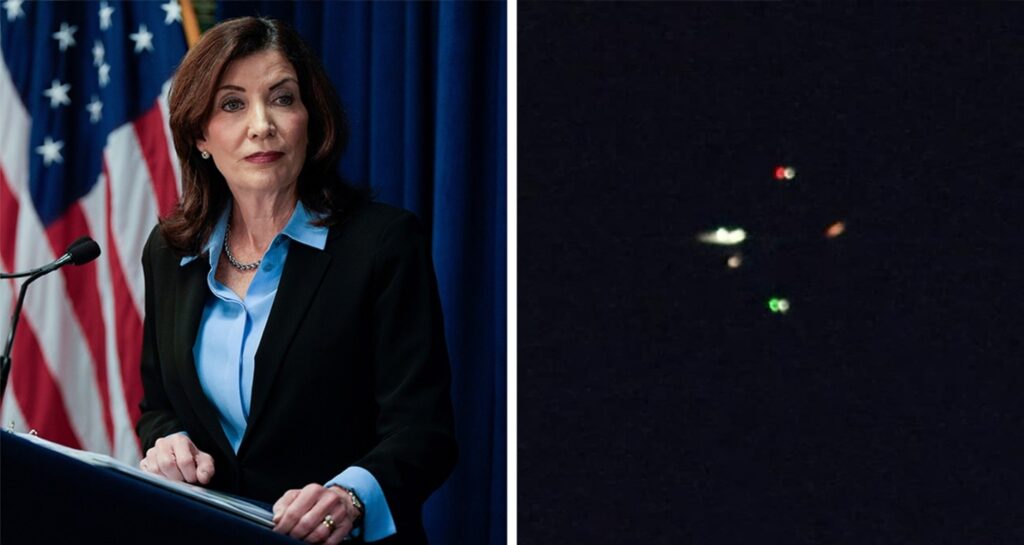Drone activity in New Jersey has alarmingly extended into New York, prompting serious concerns among state officials about the potential threats posed by these unidentified flying objects. According to a report from ABC 7 News New York, a significant incident occurred at Stewart International Airport in Orange County, New York, leading to the temporary closure of the airport’s runways last Friday night. The closure was initiated after the Federal Aviation Administration (FAA) alerted airport officials about the sighting of a drone around 9:30 p.m., an event that resulted in an hour-long halt to operations. Importantly, air traffic control recordings corroborated that pilots had reported seeing drones in the vicinity, underscoring the growing issue area. While the FAA later claimed that no aircraft were directly affected and that operations resumed as normal, the incident has raised numerous questions regarding drone regulation and oversight.
New York Governor Kathy Hochul expressed her frustration with the unfolding drone situation, evident in her statement criticizing the perceived inadequacy of federal action to mitigate these threats. Referring to the drone incursions as an “invasion,” Hochul called on Congress to act decisively and pass the Counter-UAS Authority Security, Safety, and Reauthorization Act, which aims to fortify the FAA’s authority over drone operations. The proposed legislation is designed to reform legal frameworks governing unmanned aerial systems (UAS) and grant enhanced investigative powers to state and local law enforcement officials. Hochul’s comments signal a growing urgency among local leaders to address what they perceive as a mounting threat to public safety and infrastructure, illustrating a statewide demand for federal intervention.
Furthermore, Hochul’s criticism extends to the Biden administration, indicating a belief that the federal government is failing to adequately protect New York and surrounding areas from potential drone-related threats. She called for immediate federal assistance to bolster local law enforcement capabilities, emphasizing the necessity for significant action before Congress finalizes legislation on the matter. Her insistence reflects a broader sentiment among elected officials who feel unsupported in resolving what has emerged as an escalating crisis involving drone sightings. Hochul’s plea showcases the intersection of state concerns with national security issues, as local officials push for more robust federal responsiveness to community safety needs.
Recent reports have indicated that mysterious drones have been spotted across New Jersey, with sightings documented in at least 12 counties. This unexpected proliferation has prompted local mayors to take action, reaching out to the governor for clarity and support in addressing the issue. Despite the growing number of incident reports, the Biden administration appears reticent to investigate or address these sightings adequately. National Security Council spokesman John Kirby has publicly dismissed numerous claims of drone incursions, asserting that over 3,000 reports of “car-sized drones” were likely misidentifications of other aircraft, such as helicopters or planes. Kirby’s statements, however, seem to conflict with information from military officials at facilities like Picatinny Arsenal and Naval Weapons Station Earle, which have confirmed recent incidents involving unauthorized drone breaches, further complicating the narrative.
The refusal of the Biden administration to confront the drone situation has led to speculation about the potential origins of these drones. Reports have suggested that these incidents may involve foreign adversaries, casting a shadow over national security considerations. However, the administration has dismissed these concerns, resulting in criticism from various quarters. This lack of transparent communication and the apparent minimization of the threat level have compounded frustrations among state officials who are grappling with the reality of unauthorized drone activities over sensitive areas, including U.S. military bases. The situation raises vital questions regarding government accountability and the need for robust measures to safeguard airspace and protect critical infrastructure from potential threats.
As tensions surrounding drone sightings escalate, the call for stronger regulatory measures and increased federal support appears more urgent than ever. With lawmakers, including Governor Hochul, advocating for enhanced oversight and the extension of investigative powers to local authorities, it’s evident that there is a growing consensus about the need for immediate action. The ongoing drone activities present not just a nuisance but a potential risk to safety and security. As local, state, and federal officials navigate this delicate and pressing issue, the importance of coherent communication and coordinated efforts to mitigate threats posed by drones cannot be overstated. The call for legislative reform and the demand for federal assistance highlight a broader dialogue on safeguarding airspace and addressing emerging security challenges in our increasingly technology-driven landscape.

